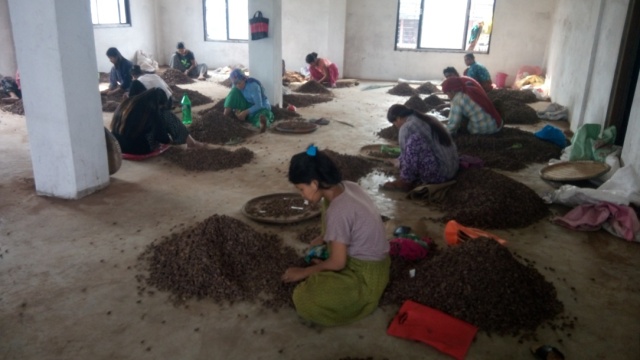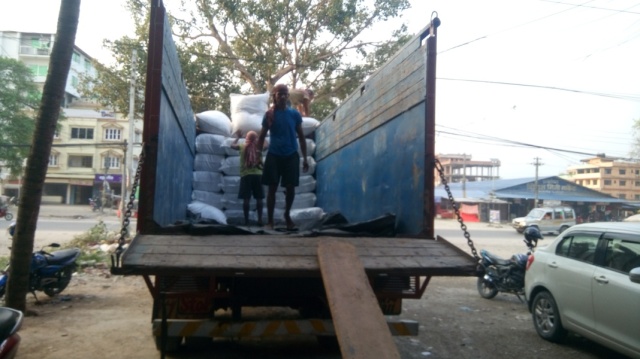By Sushant Acharya
In my past twelve years of career as a staff in development projects, I did many field visits. Unlike earlier visits, the visits I made in the first year of PhD (December, March and April) were different for me in many aspects. This time, I was not concerned with project delivery and results. I did not have office vehicle, staffs from partner organization to guide and the beneficiaries waiting for us. Moreover, these visits were opening my eyes in the long journey of research – gender relationship in high-value agriculture. My first visit was of reconnaissance type where I got an overview of production and processing and introduction with stakeholders. The second visit helped me to understand the problems more closely. Having such overview in the Eastern part of Nepal, I felt something is missing then went to visit Western part of Nepal. This blog synthesizes reflections of those visits.

Cleaning the cardamom bushes @ S. Acharya
I have selected field sites in the Eastern region of Nepal. This area has long been known for commercial production of high-value agriculture commodities. But due to high out-migration from farm sector to non-farm sector, gender relationships are changing rapidly. Researchers argue that despite of high number of women in high-value agriculture, ‘condition’ and ‘position’ have not improved relative to men. This situation is further poor in the higher nodes of value chain. Taking the case of promising commodity – cardamom, I am trying to see how the platform for men and women are constructed and why these platforms are not equal. I came up with some factors as: mobility, accessibility, access to resources (includes knowledge / skill), social norms and values and market. The subsequent sections elaborate these factors by taking support of case-stories.
We met with many people and incidents with some of them were really powerful to reshape own views. When I met the manager of local women agri-cooperative, she was selling goods from her small grocery shop. In addition to grocery, she manages furniture enterprise and cardamom farm. Her husband, on the other hand, is trainer of bee farm management. He is also local contractor for the development works. By role and income, husband and wife look equal but they differ in space of their work.

Cardamom entrepreneur briefing about processing cardamom @ S. Acharya
Her husband requires maximum mobility while she is confined to her village. Her husband drives motorbike to go around but she could not. Regarding constrain to mobility, she shared an interesting story that she pushed her husband to participate in events, on behalf of her. The simple reason was that – her husband makes this within very short-time and for her this could take hours of walk. I found many women who miss similar events due to constrain in mobility. Mobility mostly in hills is constrained either by less frequent movement of public vehicle, driving skills, poor condition of roads, or by social norms and values.

Women doing head and tail cut of large cardamom (processing) @ S. Acharya
But I met some ladies who crossed the above barriers and became successful in their profession. First one is a cardamom nursery lady. She has visited different places of the Eastern region of Nepal to learn nursery skills, promote cardamom seedlings and transfer of skills to other villagers. She first got nursery skills from the government authority, Cardamom Development Centre. Since then, she is producing high quality seedlings and making good income. We met many women who travel to market frequently to sale cardamom. But in their case, gentlemen were not at home. Similarly, the homestay lady in field site (where FATE team stayed) has travelled to different parts of India and Nepal to learn homestay management skills. She opines that women are recognized in community only when they demonstrate themselves financially independent. This reflected me that women who cross constrains can develop themselves as competent women.
I got another perspective when I talked with women from trading family. She was daughter-in-law in a Marwari (traditionally business group) family. Her family has been on cardamom business for the past three generations. By education, she holds a graduate degree and possesses knowledge and skills related to cardamom trading. But she was confined to family space – care works. When I asked her husband how she can complement their business, he responded as: “though she can complement, it is not possible in Marwadi family. But women from Pahadi (Hill) community are assisting their husbands”. Right before, we had met with lady from hill community. She was managing more than 15 wage laborers, one supervisor and trading cardamom worth hundreds of thousands rupees.

Labourers at Birtamod loading cardamom to export to India @ S. Acharya
This led me to flash back knowledge about energy that I learned in high school. A Marwadi woman possesses a maximum potential energy in terms of her capacity, but the social norms and values create barrier to her to convert potential energy into kinetic energy…
Likewise, I was surprised to see how rise and fall in price of cardamom effects in gender relationship. Three-four years back, i.e. in 2014/15, price of cardamom was in its peak i.e. 30 USD per kg. Men and women, both were engaged almost equally in farming. At that time, purchasing a motorbike, installing solar panel and having television was not a big deal even for the small farmers. Even out-migrated men were returning home because they could earn more here from cardamom. Further, they had advantage of being together with their family. But with the fall in price (i.e. in March, 2018, it was around 9 USD per kg), men are leaving, especially poor farmers, again jumping to non-farm sector and abroad jobs. They find hard to solve the problem of hands-to-mouth from cardamom and leave home parking their motorbikes in the terraces.
Such field incidences make me sometime feeling nostalgic, sometime feeling excited and sometimes my thoughts are aggressive / revolutionary. Moreover, I observed, very closely, the entire phenomenon of production, processing and trade of cardamom. I further saw how mobility, accessibility, access to resources, social norms and values and agency differ for men and women. This has provided enough ground to look more in-depth with respect to capability and role performance of women and thereby I will locate the condition and position of women. These insights will guide my entire research period.

Exactly the type of analysis and hands on evidence needed for us to grow as a self dependent, equal and inclusive nation. Hope we can put our thoughts together soon.
LikeLike